
CALIBRATING HAWK-EYE
Ever wondered how Hawk-Eye works in sport? Phil Madeley takes us through the surveying principles behind the technology
Sitting behind the JM Finn stand at the Kia Oval is a fairly ordinary-looking Transit van. The only feature that sets it apart from the TV broadcasting vans is the AC unit on its roof and the bundle of cables attached to the side. Open the van’s door and the inside is more reminiscent of an MI5 surveillance vehicle with its bank of screens, digital information and operators. This is the home of Hawk-Eye, the ball-tracking system that has been used in cricket, tennis, football and many sports ’s path so that umpires or referees can be better informed before making ultimate decisions during the match.
Open the van’s door and the inside is more reminiscent of an MI5 surveillance vehicle with its bank of screens, digital information and operators.
Hawk-Eye was initially developed by Paul Hawkins and David Sherry in 2000 whilst working for Roke Manor Research. It was first introduced to us by Channel 4 in May 2001 at a test match between England and Pakistan, initially to help analyse leg before wicket (LBW) decisions. A group of investors, lead by Wisden, saw its potential and bought the company in 2006, thus funding HawkEye’s development into other sports. In 2010 the company and product rights were bought by Sony who still own Hawk-Eye Innovations.
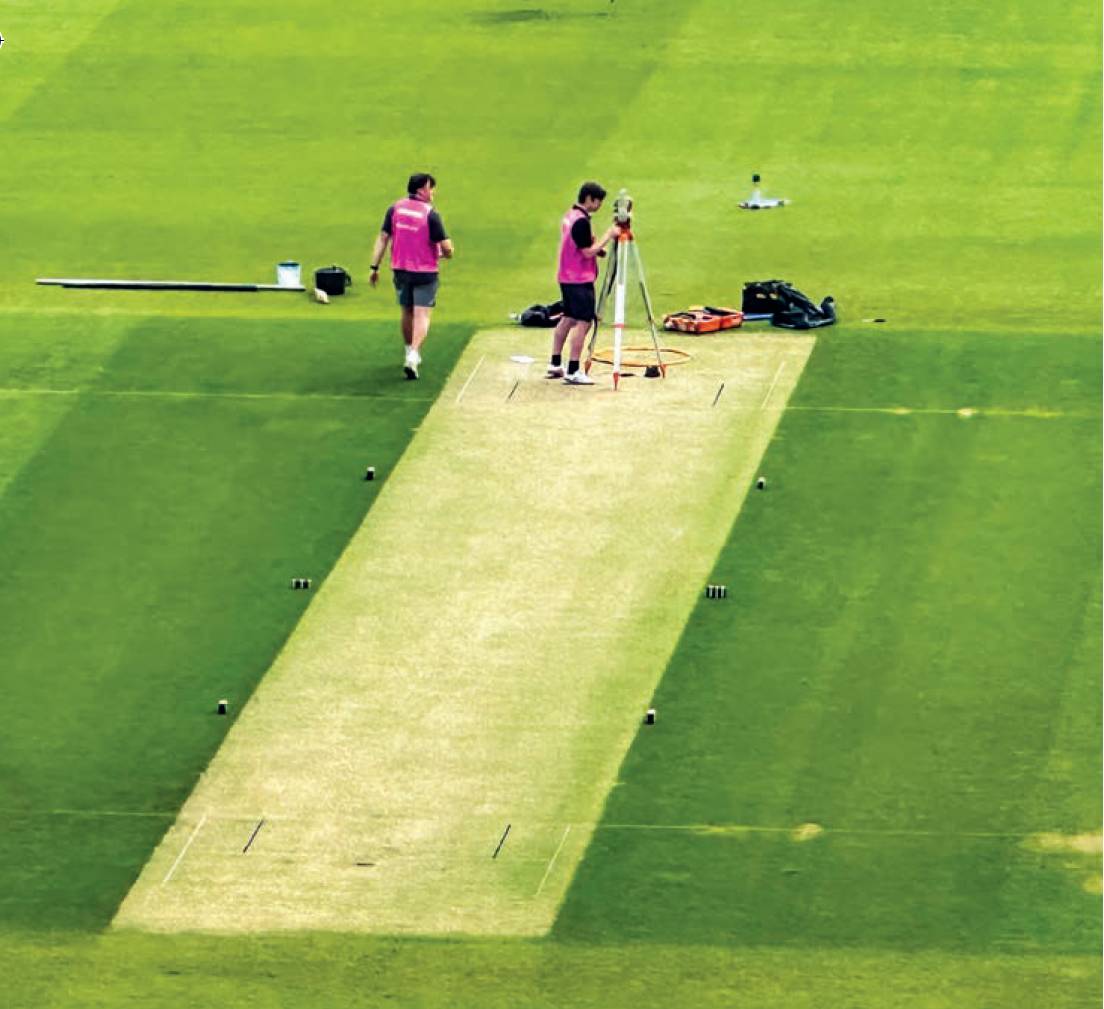
Setting up a total station to calibrate Hawk-Eye. You can see six temporary targets set up on the edge of the wicket in a line 5’ either side of the central line between the middle stumps.
The owners of Hawk-Eye agree that the system isn’t infallible, but it is striving to achieve an accuracy of 3.6mm. The positional accuracy and ball tracking prediction is dependent on the speed of the ball and the distance between the bounce, bat, batter and stumps which varies from ball to ball. The Hawk-Eye operators are able to ‘teach’ the system to predict the ball’s path by generating many thousands of ball passes and, as time increases, this prediction can only improve.
With Sony’s financial backing and the significant improvements in camera technology over the last 10 years, Hawk-Eye has been able to develop a well-renowned system. There are still doubters, but Hawk-Eye is generally acknowledged, firstly amongst professional athletes, but also commentators, sports pundits and the general public, as being a respected and trustworthy system. As well as cricket, Hawk-Eye is widely used in tennis, Gaelic football, badminton, hurling, rugby union, football and volleyball.
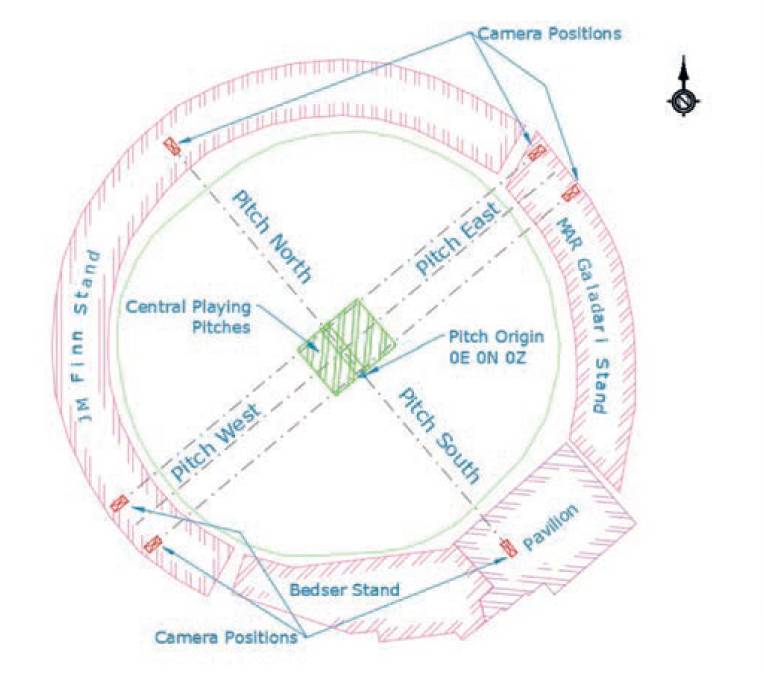
The position of six fixed cameras at the Kia Oval.
When used in cricket matches, Hawk-Eye works through the use of six to eight fixed, high speed cameras which record the position and early path of the ball at 300fps. This data is then fed back to a computer which predicts the future path of that ball to determine if the ball would have hit the stumps or has been touched by the bat or arm of the batter before being caught. In essence, HawkEye provides the third umpire with sufficient and accurate information from which they can determine if the batter is ‘in’ or ‘out’.
A cricket wicket itself is 22 yards long, between the stumps, 19 yards 1 foot between the popping or batting creases and 10 foot in width. Similarly, the stumps are 28” high and the overall width of each wicket (three stumps) is 9”. These are the only static objects in the game. Naturally no two people are the same height or size, but a cricket ball is precisely 2.8-2.86” in diameter. Hawk-Eye must determine the precise position and flight of the ball travelling at anything between 40-100 mph.
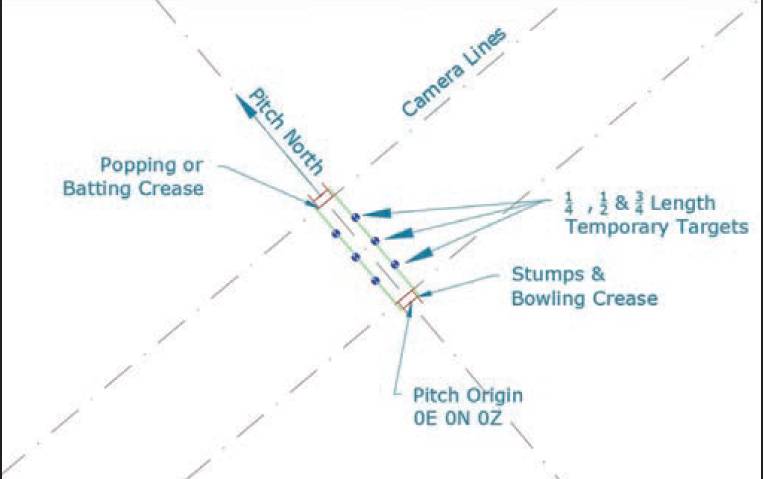
Six temporary targets are set up on the edge of the wicket in a line 5’ either side of the central line between the middle stumps. They are positioned ¼, ½ and ¾ distance between the ba›ing creases and are also coordinated in the same way as the cameras.
Hawk-Eye provides the third umpire with sufficient and accurate information from which they can determine if the batter is ‘in’ or ‘out’. Whilst I am interested in the technology behind Hawk-Eye, as a surveyor I am more interested in how Hawk-Eye understands the spatial relationship between the ball, wicket, stumps, bowler, batter and fielders. Clearly once the match has started, the wicket and stumps don’t move but all the other objects, notably the ball, are never still or fixed.
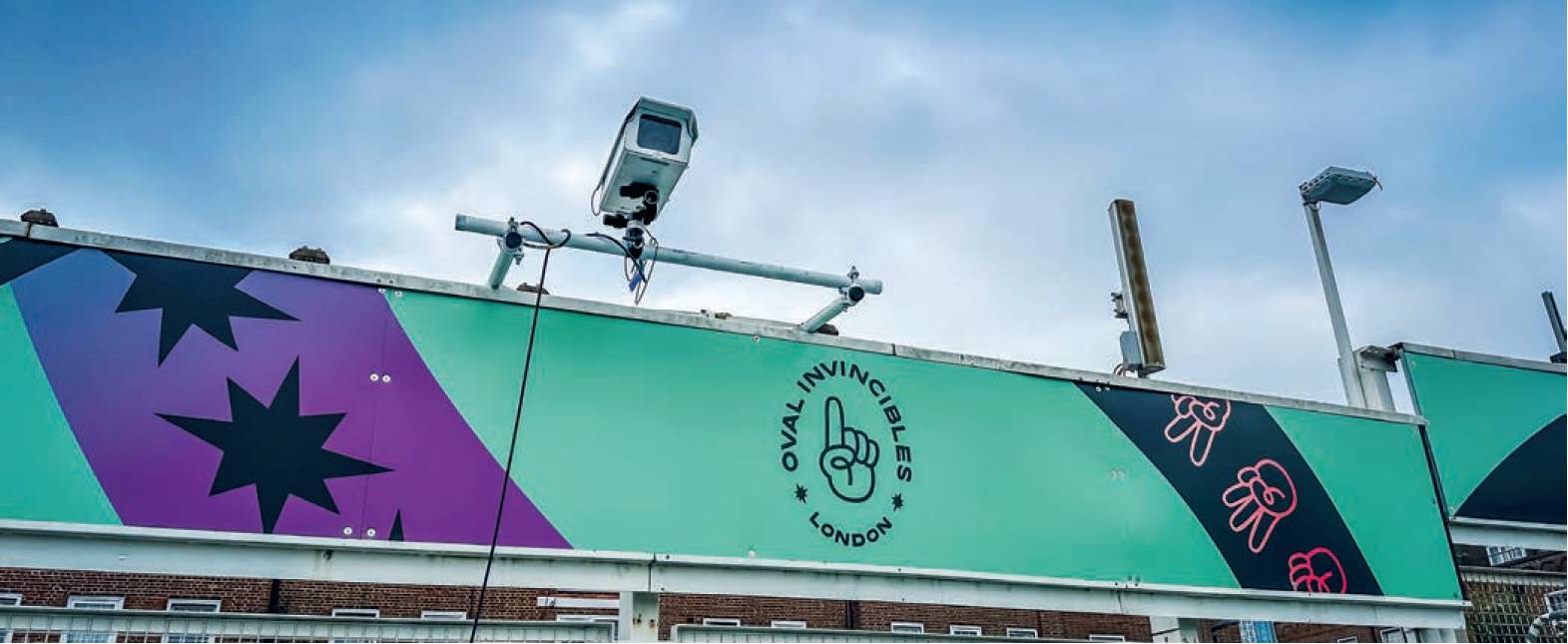
Each camera is located on a horizontal pole enabling it to be moved left or right to its correct alignment.
I work as a volunteer at The Kia Oval in SE London and, before a match one day, I noticed a chap setting up a total station at one end of the wicket. I was curious as to what he was measuring. After a few enquiries and finding the right people to talk to, the answer was obvious. He was calibrating HawkEye. But what exactly does this mean? Reference to the stylised map of the Kia Oval, you will see where the six fixed cameras are placed. One at each end of the wicket in line with the middle stump and two on each side of the wicket in line with the batting or popping crease at each end.
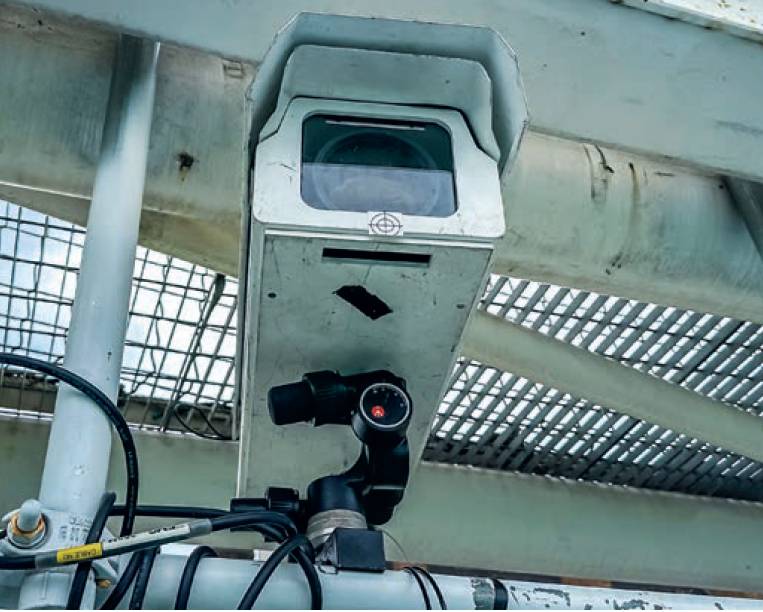
A small crosshair target sits immediately under each camera.
There are potentially 27 playing pitches at the Kia Oval but only around eight of these are used for a test match and other major televised matches. It is one these eight pitches that are used by Hawk-Eye. Clearly the same pitch isn’t used throughout the summer but once the head of grounds has decided which is to be used for that match, the Hawk-Eye team move in.
Whilst I am interested in the technology behind Hawk-Eye, as a surveyor I am more interested in how Hawk-Eye understands the spatial relationship between the ball, wicket, stumps, bowler, batter and fielders.
Hawk-Eye engineers install the six cameras in the locations described above. Each camera is located on a horizontal pole enabling it to be moved left or right to its correct alignment. This is done visually but checked to ensure that it is either in line with the wicket or at right angles to the batting crease. It is also important to ensure that each camera’s framing is set to ensure that the ball is visible at the extremes of the bowler’s release points.
Hawk-Eye works on the simple principal of using all possible cameras to triangulate the ball’s position and determine its spatial relationship with the stumps, wicket, bat and players. However, as any surveyor will know, accurate triangulation of any fixed object is only possible if the positions of each camera in relationship to the wicket are known. This conundrum becomes more complex when the object being triangulated is 2.8” ball travelling at up to 100mph.
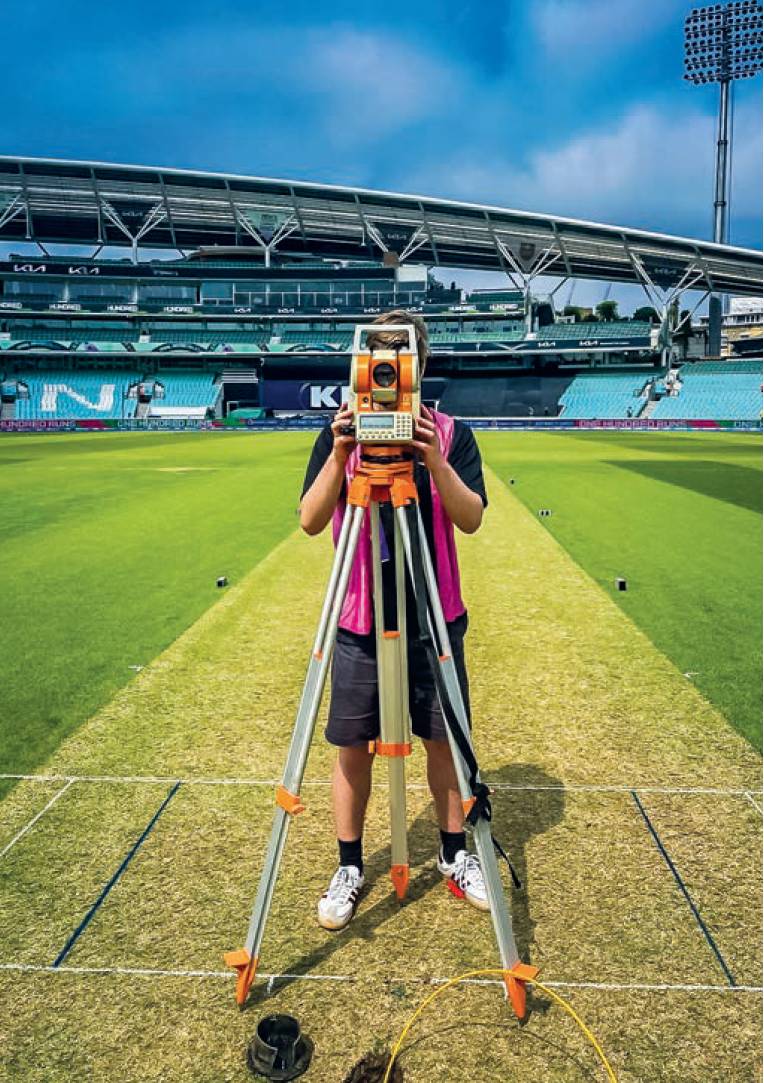
A Hawk-Eye’s engineer using a FTS300 total station to coordinate the targets.
It is difficult to imagine how Hawk-Eye’s cameras and the wicket were calibrated accurately before total stations were sufficiently well developed as they are today. It involved a tape measure, spirit level and a great deal of patience and suffice to say it would have been time-consuming and costly.
However, today’s solution to the problem is a lot easier. Hawk-Eye’s engineers use an FTS300 total station to coordinate their targets. This is a standard surveying total station with a 2” angle measuring accuracy and an electronic bubble level. More importantly it has a reflectorless distance measuring module capable of measuring up to 600m (or over 5,000m with a reflector), more than enough to measure the distances necessary within the Kia Oval and all other international cricket venues.
The process is to set the FTS300 up over the position of the middle stump at the pavilion end of the wicket. This point is given the pitch origin of 0.000E, 0.000N and 0.000Z.
The process is to set the FTS300 up over the position of the middle stump at the pavilion end of the wicket. This point is given the pitch origin of 0.000E, 0.000N and 0.000Z. The reference object for the calibration measurement is taken as the base of the middle stump at the opposite end of the wicket.
This line is then given an arbitrary bearing of 00 0’0”. The fact that any positions ‘south’ and ‘west’ of the pitch datum will have negative coordinates is ultimately irrelevant as is pitch north being about 3200 true north. The coordinates are never displayed to the television viewer so are of little consequence. This is something that might not fit well with civil engineering surveyors who are used to dealing with OSGB36 National Grid coordinates, or similar.
Once this datum and reference object (RO) bearing have been fed into the FTS300’s onboard computer, along with the height of the instrument, the engineer then sights each of the six cameras. A small crosshair target sits immediately under each camera. It is this target that the engineer sights and measures the horizontal angle (HA), vertical angle (VA) and slope distance using the FTS300’s reflectorless capability, as is done in any normal survey. Using the pitch datum coordinate, the onboard computer simply calculates the relative 3D coordinates of each camera.
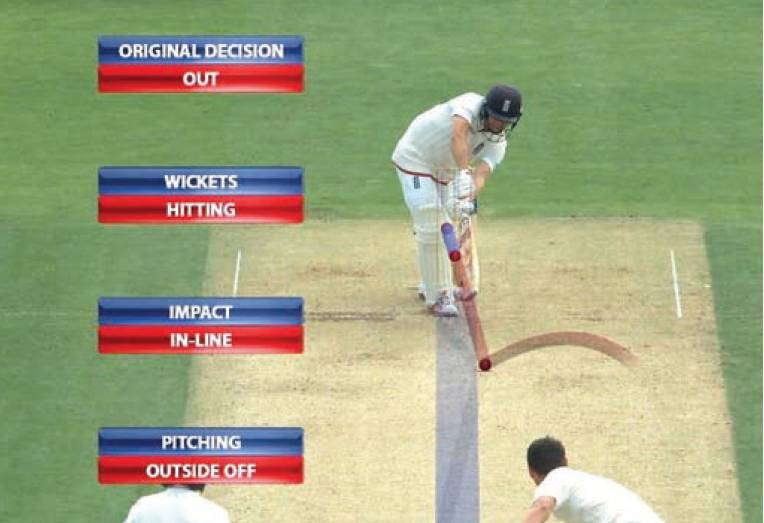
Hawk-Eye following the ball, tracking its onward path, to determine if the batter is ‘in’ or ‘out’ .
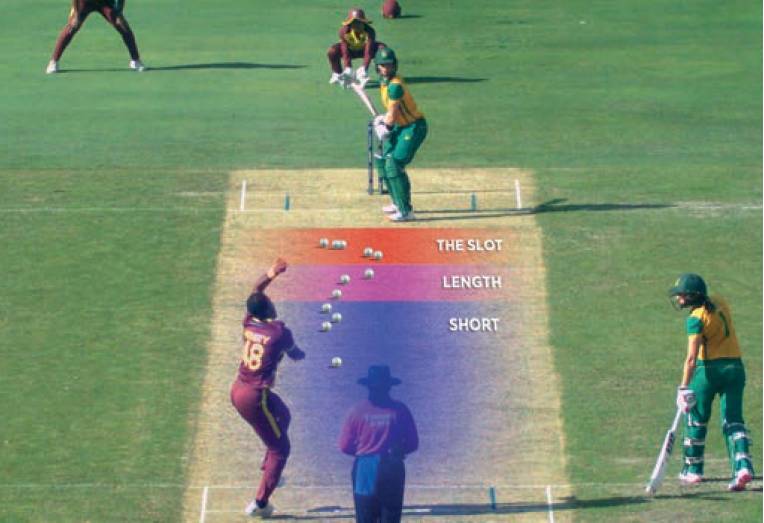
A beehive refers to a diagram that visually represents where multiple balls, usually from a specific bowler, have been delivered.
The coordinates are never displayed to the television viewer so are of little consequence. This is something that might not fit well with civil engineering surveyors who are used to dealing with OSGB36 National Grid coordinates, or similar.
The purists amongst CICES members will no doubt question the extrapolation of a 22-yard reference object distance compared to a camera measurement distance of 75-100 m. As a surveyor, we were always taught that the RO should be at least equal to or longer than the longest distance being measured.
Indeed, this would be true if we were using these dimensions to build a structure over this location. I think in this case, any minor misidentification of the RO can be excused and is unlikely to have any huge impact on the 3.6mm positional accuracy referred to by HawkEye.
Six temporary targets are set up on the edge of the wicket in a line 5’ either side of the central line between the middle stumps. They are positioned ¼, ½ and ¾ distance between the batting creases and are also coordinated in the same way as the cameras. Once these temporary targets have been coordinated, they are removed. These are used as reference points when lining up cameras, so Hawk-Eye know how much zoom is required in run-out appeals.
They also provide the TV pundits with added information. Viewers of cricket on the TV may have noticed the pundits referring to balls being bowled ‘on a length’, ‘over pitched’ or as ‘bouncers’. This term is largely governed by where the ball bounces in relationship to the hidden line crossing the wicket between these markers. Known as a ‘bee hive’, one of the more interesting data references shows where the batter intercepts the ball, either playing forward or off the back foot etc. This is useful analysis for both commentators and opposition teams alike.
Once all these objects have been coordinated, the engineer simply takes the FTS300 back to the control van and downloads the coordinates to Hawk-Eye’s system computer.
As the stumps and wicket markings are fixed objects, there is no need to coordinate these. Instead, they form a template into which can be dropped the coordinates of the cameras and temporary targets.
As the stumps and wicket markings are fixed objects, there is no need to coordinate these. Instead, they form a template into which can be dropped the coordinates of the cameras and temporary targets.
With all this data in the computer, the bowler can commence their run, the batter can attempt to hit or ensure they miss the ball, the players can appeal an LBW or catch and Hawk-Eye can follow the ball, tracking its onward path.
Howzat for a simple surveying solution to a positional conundrum!
Acknowledgements
In researching Hawk-Eye and writing this article, I would like to acknowledge the help and permission of the following people: Adam Corbett at Surrey County Cricket Club, Kia Oval for introducing me to the Hawk-Eye team at the Kia Oval and his input into some of Hawk-Eye’s analysis. Ben Davies at Hawk-Eye Innovations for his explanation of their calibration system and on-field photographs. Maddie Sheppard and Sally Harwood at the Kia Oval for giving me time off from volunteering to investigate Hawk-Eye. Rupert Dean at Surrey County Cricket Club for inspiring me to write about Hawk-Eye.